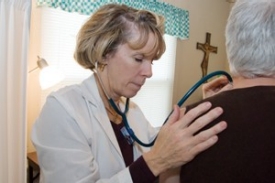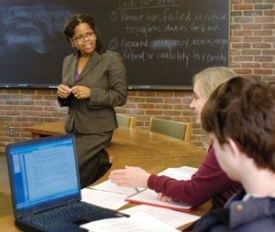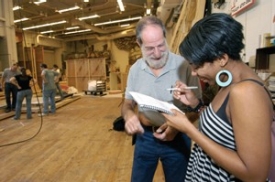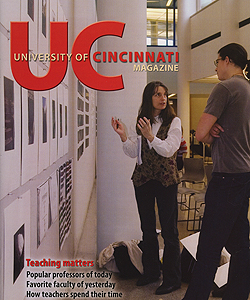Professors routinely work evenings, Saturdays, summers -- dispelling the notion that the academic life is a cushy one. No one, however, is complaining; the life has perks of its own.
How professors spend their time

Assistant professor Michael Griffith works six days a week during the school year and five days a week in the summers when he doesn't teach. The work is so satisfying that the hours don't bother him. Photo/Andrew Higley
No matter how captivating the play or opera is at the College-Conservatory of Music, the dean still looks forward to sneaking down to the scene shop during intermission to see what professor Steve Waxler and his students are up to late at night. While one show is strutting its best under the stage lights, two or three others are in the production area, many of them covered with sawdust or wet paint.
"It will be 9:30 at night," Dean Douglas Lowry says, "and Steve is in the shop with six or eight students eating Chinese food, and in the middle of the table is some gizmo for a special effect they're working on. He's discussing what's wrong with it, how you could make it work, what's going to happen if it screws up in a performance. He is someone whom I would call an around-the-clock person."
The truth is: UC is replete with around-the-clock faculty, working on and off campus at all hours of the night and weekends.
"Many science faculty are working in their laboratories at midnight," says Karen Gould, former dean of the College of Arts and Sciences, who recently accepted a provost position in California. "For those of us who are night owls, we often find that quite a few faculty members answer e-mail messages at midnight.
"The age of the Internet has catapulted the notion of a 24-7 faculty member to the nth degree," she admits, but she also notes that the academicians were never ones with structured schedules. "The academic life has always been a life of books, reflection, laboratories and places where faculty members go even after no one else is there."
That's not the impression one would get by giving faculty workloads a cursory glance: summers off, Christmas breaks, spring breaks, teaching only two or three classes during the academic year and keeping occasional office hours. It all looks pretty attractive.
National surveys, however, indicate that the average university faculty member works 50 hours a week. And although schedules change during the summer, they don't go away.
"Too often, the public labors under the misconception that university faculty work only those hours when they're in a classroom," says Michael Griffith, assistant professor of English and comparative literature. "But I work six days a week, all-day long, 33 weeks a year."
Before anyone gets too excited over his 33-week calendar, let it be noted that he was talking about a school year's three 10-week quarters and three weeks of breaks. Summers are another matter. "I'm in the office 9 to 5 every day, all summer, and I come in every Saturday," he adds.
The hours are actually worse than that, says Roger Daniels, an emeritus professor of history who retired in 2002. "It is not just a 9-to-5 job. Teaching is almost a 24/7 proposition if you do it properly. If I could get my hands around the neck of the person who first started defining a teacher's workload as classroom hours, I'd strangle them," he says.
Nevertheless, no one is complaining. Griffith does take a vacation, and the summer schedule is his favorite. That's when he gets to write -- full time, all summer.
"As faculty, we get to do what we care about doing," he says. "I'm a fiction writer. UC gives me the opportunity to do my teaching and still write. It's a good gig. Most appreciate that and do their work conscientiously."
English-lit colleague, associate professor James Schiff agrees. "The truth of the matter is that while I did travel with my family last summer, I generally worked full weeks when I was out of town." He also spent the summer reading four PhD dissertations and attending those defenses, preparing budgets and speaker programs for the upcoming school year, meeting with students and writing recommendation letters, trying to keep up with new readings in his field and, in his spare time, writing reviews and essays, editing a book and serving as a peer review reader for journals.
"While my colleagues and I probably haven't worked quite as hard as my old investment banker friends in New York City, I'd wager we've put in as many or more hours this summer than most American workers." he says. "For whatever reason, though, while the public is quick to point out that teachers supposedly don't work an entire year, no one ever accuses the college basketball coach -- and I'm a big fan of college basketball -- of only working from December to March, or of working only four hours a week, the time two basketball games consume."

Associate professor of nursing Christine Colella loves the community service she does each month, volunteering to provide health care at an Indiana clinic for the under-served. Photo/Dottie Stover
University of Cincinnati associate professor Christine Colella, Nurs '81, MS (Nurs) '88, admits she didn't know how busy she would be when she left the private medical field 11 years ago to join the College of Nursing faculty. But she also says the workload is partially self-imposed because she enjoys the challenge of trying so many different endeavors.
"I've taught freshmen, grad students and every year in between -- across the continuum of what nursing has to offer. I've also written articles and grants, made presentations at national and international levels. Those are experiences I wouldn't get elsewhere.
"Then there's the committee work, which I feel strongly about. As faculty, we need to be good citizens to the college and the university.
"The longer you're here, the more exposure you get to other things," she adds. "You prove yourself, then you get to do more. You get sucked up into all this stuff. It's like a vortex.
"It's exhausting, but it's exciting. I've been very lucky. I feel really blessed."
On one hand, faculty are expected to engage in research or scholarship and assume administrative responsibilities. On the other hand, professors naturally do it because they have high expectations of themselves, one of the outcomes of recruiting premier faculty to begin with.
Besides teaching and grading, faculty also mentor, recruit impressive students and other faculty, obtain funding for research and special projects, discover innovations in their fields, patent inventions, write textbooks, give guest lectures, consult, lead field trips, stay abreast of new philosophies, convene conferences and generally further the scholastic enterprise of higher education. Summers generally provide much-needed catch-up time for research conferences, collaborative efforts with other colleagues and developing new curriculum.
In many ways, it's an odd combination of playing human resource director, admissions counselor, financial officer, business manager, development VP and convention planner, depending upon one's field.
"Faculty are the lifeblood of the college," says College of Law Dean Louis Bilionis. "They formulate its policy. They define its vision. They work to achieve it, including what the curriculum should look like, how to innovate it, delivering it. The culture of the college is one of the faculty."
"Our faculty members are responsible for creating, maintaining and overseeing the quality of the learning and research environment," former UC A&S dean Karen Gould says. "Without their strong engagement and creative involvement, we cannot be a premier university. That's a fundamental tenet and one we should not lose sight of."
That means if a university is going to be on the leading edge, its faculty members have to be out there discovering where that edge lies. "We have an outstanding faculty pushing the boundaries of research and engaged in scholarly dialogue about what other scholars are finding out," Gould adds. "They are very interested in what their research fields are accomplishing at other major universities, as well as in their own units, to ensure that they are actually bringing something new to the table."
Because law and law practices change constantly, Dean Bilionis says his faculty have to stay keenly aware of what is happening in the field and what will happen next. "Our professors typically teach only two courses at a time, but their preparation time is extraordinary. They're constantly reviewing the law, re-reading, reflecting, preparing approaches to use in class and doing more research.
"Part of what we do is help to be constructive in reforming the law, making it better. We're living in an increasingly global society, so the issues to which lawyers need to be sensitive expand greatly.
"We think it's important that we introduce students to the ways in which law is informed by insights of other disciplines. We're preparing lawyers to practice tomorrow, not just today."

Among the responsibilities law professor Verna Williams has outside the classroom is serving as faculty adviser for the Black Law Students Association. Photo/Lisa Ventre
University of Cincinnati Law professor Verna Williams especially loves her interdisciplinary work. She and professor Kristin Brandser joined the college, in part, to expand its existing joint degree program in law and Women's Studies. The capstone experience for this four-year program is in a public-interest externship in which Williams and Brandser supervise students working at national nonprofit organizations, like the National Women's Law Center in Washington, D.C., where Williams worked before joining the faculty five years ago.
She is also working with the Ford Foundation "to revitalize the women's movement" and serves as a faculty adviser for a new journal that partners with Cincinnati's National Underground Railroad Freedom Center Museum.
"The academic life," she points out, "is a three-legged stool of scholarship, service and teaching. It's a great way to work on the stuff that you care about and to do it in a thoughtful and strategic way, then share it with others.
"What's nice about the academic life is you get to be very entrepreneurial. You decide what your research agenda is going to be, and you can teach courses that complement it. The stuff I teach informs my research. My research informs my teaching. My service informs both. It's a nice integrated way of working.
"The variety works great for me," she says. "In some ways, it doesn't feel like work because it's really fun."
At the Academic Health Center, the "three-legged stool" comprises clinical care, research and education, though no one faculty member focuses evenly on all three. A faculty researcher whose salary is totally supported by federal grants, for instance, may lecture only occasionally.
At University Hospital, surgeons who are on faculty may spend the majority of their time taking care of patients, but students and residents are learning as they accompany them. Elsewhere professors may spend the majority of their time in traditional classrooms. "Each person is making an important contribution," says College of Medicine Dean David Stern. "By putting them together, you end up fulfilling the mission of the college."
The classical model for medical faculty was to spend a portion of each day involved in all three areas, but a shift occurred as society became more specialized. Today, clinical faculty are more likely to be performing open-heart surgery than "taking out appendixes and delivering babies as we did," says the dean, referring to his years at Columbia University. "We end up with a more complex kind of physician."
As for researchers, they have a more difficult time obtaining grants now. The National Institutes of Health, for example, basically funds only one out of every 10 applications, no longer leaving room for "people who are just dabbling in research," he says.
And in the classroom, medical education has become almost customized. Simulators let students progress at their own speed, replacing some of yesterday's "cookie cutter" teaching methods, as Stern calls it.
"If someone is a boob with his hands, it might take him longer to learn a procedure than the student next to him. What we really want is the training adjusted so that everyone comes out competent."
To help reach that goal, videos are shot in clinical skills labs to show students how they interact with "standardized patients," actors trained to respond in ways that test students' abilities. Afterward, faculty must review tapes and meet with individual students to discuss both their medical and interpersonal skills. "People have much more rigorous training now," he notes, "but it takes more time to administer that kind of training.
"Plus, you have to continuously update yourself so you are attuned to what is happening in your field. It's a lifelong process. I read journals virtually every night. I still write and review papers. It's a lifestyle."
The lifestyle of a professor is slightly different, but equally demanding for Steve Waxler and his colleagues at the University of Cincinnati College-Conservatory of Music, where faculty meet demanding schedules for individualized instruction, recitals, coaching, consulting and performing -- all on top of regular classroom instruction.
Maintaining outside careers is the norm for CCM faculty. "In the very best schools of performing arts in America," Dean Douglas Lowry says, "the more productive faculty members are active in their profession, nationally and internationally. That component is something we expect our faculty to fulfill and one of the reasons the very best students come to a school like this.

Working in the scene shop is a never-ending job for Steve Waxler, department chair for theater design and production (shown here with drama junior Sarah Stephens). Photo/Lisa Ventre
"We also have high expectations for our scholar faculty to produce scholarship that is relevant at the highest levels in their profession. That requires a tremendous amount of outside time for research, consultation of other colleagues in their profession and writing. "I know people tend to focus on the classroom teaching experience as the only true measurement of how faculty members spend their time, but that is only a small portion of what they actually do."
In the theater design and production area, for instance, faculty generally teach in the mornings, then supervise students in lab settings from 1 to 6 p.m. That's the easy schedule. Adding on production schedules is grueling. "Once we flip into the actual rehearsal week, that's when people can be up till 3 and 4 in the morning," the dean adds. "They don't exist on a normal rehearsal clock. They rehearse and rehearse and rehearse, until they get it right."
Waxler, department chair for theater design and production, has lived with the irregular hours since 1970 and admits that it can be tough. Still, he keeps coming back for more. Why? "Every once in a while, I turn around and ask myself that," he laughs. "I do it for the love of the art and for the love of the students.
"Over the years, I've seen a number of faculty get tired and start looking around. They'll get offers from other schools, but when they look at what we do here, they say they can't leave.
"The level of performance from all the students, the level of talent, the level of production is so high here. I would go crazy if I were at some of the other schools." He tells of a sophomore stage manager who recently came to him saying, "Thank you. Thank you for everything." The student had been working on CCM's production of "The Pajama Game" when he saw the play at another school. "I now understand why we do what we do," he told Waxler.
"That's what gets me up every morning to come in," Waxler says contentedly.
Contentment among faculty is contagious, says law dean Louis Bilionis. "They work hard," he says. "They work all hours. It's just that you don't see them working at home at 11 o'clock on a Saturday.
"Don't pity them, though. They enjoy their work. It's a privilege."

 Issue Archive
Issue Archive